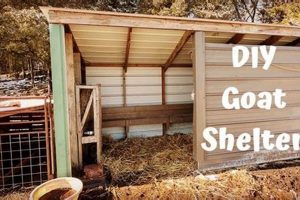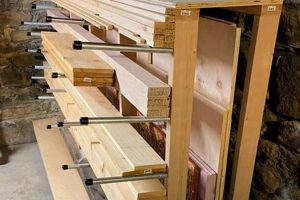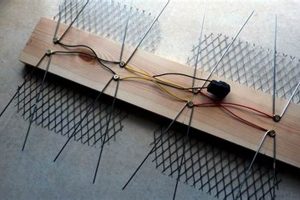A self-constructed garden structure, frequently featuring an arched form, is a common landscaping element. These structures can be crafted from a variety of materials, including wood, metal, or even repurposed items, and are intended to enhance garden aesthetics. An example includes a wooden framework assembled by a homeowner to support climbing roses at the entrance to a vegetable garden.
The creation of personalized garden features offers numerous advantages, including cost savings compared to purchasing pre-made options. Furthermore, it allows for customization, enabling the structure to perfectly complement the specific dimensions and design of the garden. Historically, such projects represent a tradition of resourcefulness and individual expression in horticultural practices.
The following sections will delve into the practical considerations involved in creating such garden features, covering material selection, construction techniques, and design considerations relevant to ensuring structural integrity and visual appeal. Specific attention will be paid to adapting designs to various garden styles and available resources.
DIY Garden Arch
Constructing a garden arch requires careful planning and execution. The following tips are intended to provide guidance in ensuring a successful and durable outcome.
Tip 1: Material Selection is Paramount: The choice of material directly influences the arch’s lifespan and aesthetic. Pressure-treated lumber offers resistance to rot and insect damage, while metal provides enhanced structural strength. Consider the climate and prevailing weather conditions when making this selection.
Tip 2: Precise Measurements are Critical: Accurate measurements are essential for a stable and visually pleasing structure. Measure the desired width, height, and depth of the arch before commencing construction. Ensure that the foundation posts are set at consistent intervals.
Tip 3: Prioritize Structural Integrity: Employ robust joinery techniques, such as mortise-and-tenon or bolted connections, to ensure the arch can withstand external forces. Reinforce weak points with bracing or additional support beams.
Tip 4: Secure the Foundation: The foundation is the most crucial element. Bury support posts deep into the ground and encase them in concrete to provide a stable base. This is particularly important in areas with high winds or unstable soil.
Tip 5: Account for Plant Growth: When designing the arch, consider the eventual size and weight of the plants that will be supported. Ensure sufficient space for growth and that the structure can bear the added load.
Tip 6: Apply Protective Finishes: Protect the arch from the elements with a sealant, paint, or stain. Regularly inspect the finish and reapply as needed to prevent rot, rust, or weathering.
Tip 7: Consider Drainage: Proper drainage is essential to prevent water accumulation and potential damage. Design the foundation to allow water to drain away from the base of the posts.
Following these recommendations will contribute to the creation of a durable and aesthetically pleasing garden arch that enhances the landscape for years to come.
The subsequent sections will address design considerations, plant selection, and ongoing maintenance strategies.
1. Material Durability
Material durability is a critical determinant of a garden arch’s lifespan and structural integrity. When constructing a garden arch, the selection of materials directly impacts its ability to withstand environmental stressors such as moisture, temperature fluctuations, and pest infestations. Consequently, the choice of inappropriate materials often leads to premature deterioration, structural failure, and increased maintenance demands. For example, using untreated softwood in a damp climate will inevitably result in rot, weakening the structure and necessitating costly repairs or complete replacement within a short period.
Conversely, selecting durable materials like pressure-treated lumber, naturally rot-resistant woods (e.g., cedar or redwood), or powder-coated metal significantly extends the arch’s service life. Pressure treatment infuses wood with preservatives, rendering it resistant to decay and insect damage. Metal, when properly coated, resists corrosion from moisture and chemicals. The practical significance of understanding this relationship is evident in the reduced long-term costs associated with maintenance and replacement. A well-constructed arch using durable materials can provide years of reliable service and aesthetic appeal with minimal upkeep.
In conclusion, the relationship between material durability and the longevity of a garden arch is undeniable. Careful consideration of material properties is essential to ensure a sound investment. Understanding this connection allows for informed decision-making, minimizing the risk of structural failures and maximizing the value derived from the garden feature. Challenges associated with material selection often involve balancing cost considerations with the long-term durability requirements specific to the local climate and intended use of the arch.
2. Structural Stability
The structural stability of a self-constructed garden arch is paramount to its functionality and longevity. It represents the capacity of the arch to withstand external forces, such as wind, snow, and the weight of mature climbing plants, without deformation or collapse. The consequence of neglecting structural stability is evident in arches that succumb to the elements, potentially causing damage to surrounding vegetation or posing a safety hazard. The fundamental importance lies in the arch’s ability to maintain its designed form and function under varying environmental conditions. For example, an arch constructed with insufficient bracing may lean or buckle under the weight of a heavy wisteria vine, ultimately requiring costly repairs or complete replacement.
Practical application of structural stability principles involves careful design and construction techniques. This includes selecting appropriate materials with sufficient load-bearing capacity, employing robust joinery methods, and ensuring a stable foundation. For instance, using oversized lumber for key structural components and anchoring the arch posts in concrete footings contributes significantly to its overall stability. Furthermore, the use of diagonal bracing or gussets reinforces the structure against lateral forces, preventing swaying or tipping. Consideration must also be given to the soil type and drainage conditions, as these factors influence the foundation’s ability to support the arch’s weight.
In summary, structural stability is an indispensable attribute of any successful self-constructed garden arch. Prioritizing sound engineering principles and employing durable materials are essential for ensuring a safe and lasting garden feature
. Addressing the challenges associated with structural integrity requires a comprehensive understanding of load distribution, material properties, and environmental factors. Properly integrating these elements contributes not only to the aesthetic appeal but also to the enduring functionality of the structure.
3. Design Aesthetics
The visual appeal of a self-constructed garden arch, or design aesthetics, is intrinsically linked to its integration within the overall landscape. The successful melding of structural form with surrounding botanical and architectural elements contributes significantly to the perceived value and aesthetic harmony of the outdoor space. The conversea design incongruent with its settingresults in a visual discord, diminishing the intended enhancement to the garden. For instance, a rustic, wooden arch might complement a cottage-style garden, whereas a sleek, metal structure could better suit a modern, minimalist design. The cause-and-effect relationship is evident: thoughtful design choices yield a cohesive and pleasing visual experience, while their absence produces a disjointed and unattractive result.
Practical applications of design aesthetics principles include considering the arch’s proportions relative to its surroundings, selecting materials and finishes that complement existing features, and paying attention to the interplay of light and shadow. The arch functions as a focal point; therefore, its design should draw the eye and guide movement through the garden. The selection of climbing plants also plays a crucial role. A vibrant bougainvillea might enhance the impact of a bold, contemporary arch, while delicate clematis would softly adorn a traditional, wooden structure. The interplay of form and foliage allows for customization reflecting an individual’s aesthetic preferences, ultimately shaping the character of the garden.
In summary, design aesthetics represents a fundamental component in the effective implementation of a garden arch. By carefully considering the arch’s style, materials, and proportions, alongside the selection of compatible plants, one can create a harmonious and visually engaging garden feature. The challenges associated with design integration are often overcome through careful planning and an awareness of the existing landscape’s aesthetic qualities, transforming a simple structure into an elegant focal point within the garden.
4. Plant Compatibility
Plant compatibility is a crucial determinant of a garden arch’s long-term success and aesthetic appeal. The interaction between the structure and the selected plant species directly influences the arch’s structural integrity, maintenance requirements, and visual impact. An ill-suited plant can overwhelm the structure, leading to damage or collapse, while a properly matched pairing creates a harmonious and sustainable garden feature. For example, planting a vigorous grapevine on a lightweight, unbraced arch will invariably result in structural failure due to the plant’s weight and expansive growth. Conversely, a delicate climbing rose on a robust arch offers a balanced and visually pleasing composition, enhancing both the plant’s and the structure’s appeal.
Practical application of plant compatibility principles involves considering the plant’s growth habit, mature size, weight, and support requirements. Matching these characteristics with the arch’s dimensions, material strength, and design is essential. For instance, heavy, woody climbers such as wisteria necessitate sturdy arches constructed from durable materials like pressure-treated lumber or metal. Lightweight annual vines like morning glories or sweet peas are suitable for less robust structures. Consideration must also be given to the plant’s sunlight and water needs to ensure its healthy growth and prevent damage to the arch. Selecting plants appropriate for the local climate is also important to ensure the survival and longevity of the vegetation.
In summary, plant compatibility represents a critical factor in achieving a successful and aesthetically pleasing garden arch. By carefully considering the plant’s characteristics and matching them with the arch’s design and materials, one can create a sustainable and visually harmonious garden feature. The challenges associated with plant compatibility often stem from a lack of understanding of plant growth habits and structural limitations. Careful planning and informed plant selection, however, can mitigate these challenges, resulting in an enduring and beautiful addition to the landscape.
5. Foundation Strength
The stability and longevity of a self-constructed garden arch are inextricably linked to the strength of its foundation. The foundation serves as the primary anchor, resisting forces exerted by wind, soil conditions, and the weight of the structure itself, particularly when supporting mature climbing plants. Inadequate foundation strength inevitably leads to structural instability, resulting in leaning, tilting, or even complete collapse of the arch. A common scenario involves a wooden arch with shallowly buried posts, which, after a period of heavy rainfall or strong winds, becomes dislodged and topples over, damaging surrounding plants and requiring costly reconstruction. Therefore, a robust foundation is not merely a desirable attribute but a fundamental requirement for a durable and safe garden arch.
The practical implementation of foundation strength involves several key considerations. The depth and width of the footings must be appropriate for the arch’s size and the prevailing soil conditions. In areas with loose or unstable soil, wider and deeper footings are necessary to provide adequate support. Concrete encasement of the posts is a common technique to distribute the load and prevent rot. The type of concrete mix and the use of reinforcing steel can further enhance the foundation’s strength. Drainage considerations are also essential; proper drainage prevents water accumulation around the base of the posts, mitigating the risk of frost heave and premature decay. Furthermore, the alignment and leveling of the foundation posts are critical for ensuring the arch’s vertical stability and preventing uneven stress distribution.
In conclusion, foundation strength is a non-negotiable aspect of a successful self-constructed garden arch. A well-engineered and executed foundation ensures the arch’s structural integrity, safety, and long-term aesthetic appeal. Addressing the challenges associated with foundation design requires a thorough understanding of soil mechanics, load-bearing principles, and construction techniques. Properly prioritizing and implementing these elements transforms a simple garden feature into a lasting and valuable addition to the landscape, capable of withstanding environmental stressors for years to come.
6. Weather Resistance
The longevity and visual integrity of a self-constructed garden arch are fundamentally dependent on its resistance to prevailing weather conditions. Environmental factors, including rain, sno
w, solar radiation, and temperature fluctuations, exert constant stress on the structure. Insufficient weather resistance invariably leads to premature degradation, structural weakening, and aesthetic decline. For instance, an untreated wooden arch exposed to prolonged moisture is susceptible to rot, fungal growth, and insect infestation, ultimately compromising its stability and requiring costly repairs or replacement. Consequently, incorporating appropriate weather-resistant measures during construction is paramount to ensuring the arch’s durability and preserving its intended purpose.
Practical strategies for enhancing weather resistance encompass material selection, protective coatings, and design considerations. Choosing naturally durable materials, such as cedar or redwood, or employing pressure-treated lumber provides inherent resistance to decay and insect damage. The application of protective finishes, including paints, stains, or sealants, further shields the structure from moisture penetration and UV radiation. Design features that promote water runoff and prevent water accumulation, such as sloping surfaces and adequate drainage, also contribute to weather resistance. Furthermore, selecting corrosion-resistant fasteners and hardware is crucial for preventing rust and maintaining structural integrity over time. Regular inspection and maintenance, including reapplying protective finishes as needed, are essential for extending the arch’s lifespan and minimizing the impact of weathering.
In summary, weather resistance is an indispensable attribute of a self-constructed garden arch. Prioritizing weather-resistant materials, finishes, and design features is essential for ensuring the structure’s durability, aesthetic appeal, and long-term performance. Addressing the challenges associated with weathering requires a proactive approach, encompassing careful planning, informed material selection, and regular maintenance. By effectively mitigating the effects of environmental stressors, one can create a lasting and visually pleasing garden feature that enhances the landscape for years to come.
Frequently Asked Questions
The following section addresses common inquiries regarding the design, construction, and maintenance of garden arches. It aims to provide clarity and guidance on various aspects relevant to ensuring a successful and long-lasting structure.
Question 1: What is the optimal material for constructing a garden arch in a region with significant rainfall?
Pressure-treated lumber or naturally rot-resistant wood species such as cedar or redwood are recommended. These materials offer enhanced resistance to moisture damage, mitigating the risk of rot and decay. Metal structures, properly coated to prevent corrosion, are also a viable option.
Question 2: How deep should the foundation posts be buried to ensure adequate stability?
The depth of the foundation posts should be at least one-third of the total arch height. In unstable soil conditions, deeper footings or concrete encasement may be necessary to provide additional support and prevent movement.
Question 3: What type of joinery is most suitable for connecting the structural components of a garden arch?
Mortise-and-tenon joints, lap joints, or bolted connections are all effective methods for joining structural components. The choice of joinery depends on the materials used, the arch’s design, and the desired level of structural integrity. Reinforcing joints with metal brackets or gussets can further enhance stability.
Question 4: How can the arch be protected from excessive sun exposure and UV damage?
Applying a UV-resistant sealant, paint, or stain can help protect the arch from the damaging effects of solar radiation. Regular reapplication of these protective coatings is essential for maintaining their effectiveness.
Question 5: What climbing plants are best suited for a small garden arch?
Lightweight, non-aggressive climbers such as clematis, climbing roses (smaller varieties), or annual vines (e.g., morning glory, sweet pea) are suitable for smaller arches. Avoid vigorous growers that can overwhelm the structure or require excessive maintenance.
Question 6: How frequently should a garden arch be inspected for signs of damage or wear?
A garden arch should be inspected at least twice a year, preferably in the spring and fall. Look for signs of rot, insect damage, loose joints, or corrosion. Address any issues promptly to prevent further deterioration and ensure the arch’s continued safety and stability.
In summary, the successful creation of a garden arch hinges on careful material selection, robust construction techniques, and proactive maintenance. Attention to these details ensures a durable and aesthetically pleasing addition to any garden setting.
The following section will provide detailed guidance on specific design considerations for various garden styles.
Conclusion
This exploration of the construction of self-assembled garden arches has underscored the importance of material selection, structural integrity, and aesthetic compatibility. Successful projects necessitate careful planning and execution, accounting for environmental factors and plant characteristics to ensure longevity and visual harmony. A durable and well-designed structure enhances the landscape, providing a focal point and supporting climbing vegetation.
The principles outlined herein serve as a foundational guide for realizing a successful garden arch project. By prioritizing structural soundness and aesthetic integration, individuals can create enduring and visually compelling features that enrich their outdoor environments, fostering a symbiotic relationship between architecture and nature. Continued adherence to sound construction practices will ensure the sustained value and enjoyment derived from this landscape element.







